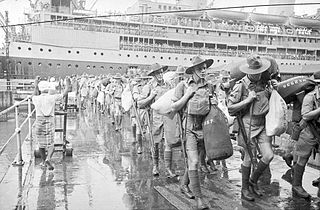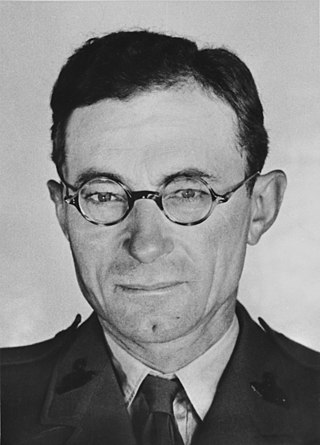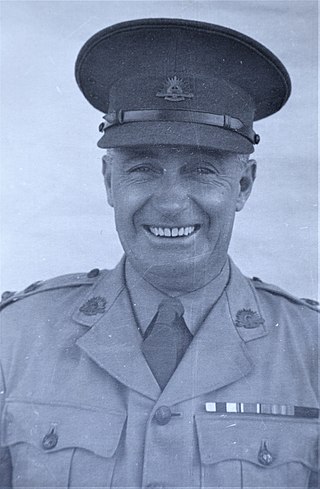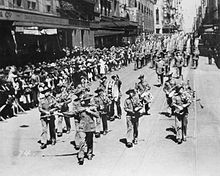
The 8th Division was an infantry division of the Australian Army, formed during World War II as part of the all-volunteer Second Australian Imperial Force. The 8th Division was raised from volunteers for overseas service from July 1940 onwards. Consisting of three infantry brigades, the intention had been to deploy the division to the Middle East to join the other Australian divisions, but as war with Japan loomed in 1941, the division was divided into four separate forces, which were deployed in different parts of the Asia-Pacific region. All of these formations were destroyed as fighting forces by the end of February 1942 during the fighting for Singapore, and in Rabaul, Ambon, and Timor. Most members of the division became prisoners of war, waiting until the war ended in late 1945 to be liberated. One in three died in captivity.

Lieutenant Colonel Charles Groves Wright Anderson was a South African-born Australian soldier, farmer, and politician. He was a recipient of the Victoria Cross and a member of the Australian House of Representatives.

The fall of Singapore, also known as the Battle of Singapore, took place in the South–East Asian theatre of the Pacific War. The Japanese Empire captured the British stronghold of Singapore, with fighting lasting from 8 to 15 February 1942. Singapore was the foremost British military base and economic port in South–East Asia and had been of great importance to British interwar defence strategy. The capture of Singapore resulted in the largest British surrender in its history.

The Japanese 25th Army was an army of the Imperial Japanese Army during World War II, noted for its role in the Malayan Campaign and the Battle of Singapore.

The Malayan campaign, referred to by Japanese sources as the Malay Operation, was a military campaign fought by Allied and Axis forces in Malaya, from 8 December 1941 – 15 February 1942 during the Second World War. It was dominated by land battles between British Commonwealth army units and the Imperial Japanese Army, with minor skirmishes at the beginning of the campaign between British Commonwealth and Royal Thai Police. The Japanese had air and naval supremacy from the opening days of the campaign. For the British, Indian, Australian, and Malayan forces defending the colony, the campaign was a total disaster.

The 20th Battalion was an infantry battalion of the Australian Army. Raised in early 1915 as part of the Australian Imperial Force, it was attached to the 5th Brigade, 2nd Division that served during World War I. The battalion first saw action during the Gallipoli campaign, before being evacuated in December 1915. After that the 20th Battalion was sent to France where they served in the trenches along the Western Front. Over the course of the next two years, they fought in many major battles, including the battles of the Hundred Days Offensive at the end of the war. The 20th Battalion's last engagement was at Montbrehain in October 1918. Following the end of the war, it was disbanded in April 1919. It was later re-raised in 1921, although it was amalgamated in 1929 due to manpower shortages. During World War II the battalion was briefly re-raised and carried out garrison duties in Australia.
The Malaya Command was a formation of the British Army formed in the 1920s for the coordination of the defences of British Malaya, which comprised the Straits Settlements, the Federated Malay States and the Unfederated Malay States. It consisted mainly of small garrison forces in Kuala Lumpur, Penang, Taiping, Seremban and Singapore.

The Battle of Muar was the last major battle of the Malayan Campaign during the Second World War. It took place from 14–22 January 1942 around Gemensah Bridge and on the Muar River. After the British defeat at Slim River, General Archibald Wavell, commander of ABDA, decided that Lieutenant General Lewis Heath's III Indian Corps should withdraw 240 kilometres (150 mi) south into the State of Johore to rest and regroup, while the 8th Australian Division would attempt to stop the Japanese advance.

The 2/30th Battalion was an infantry battalion of the Australian Army that served during World War II. Raised in late 1940 as part of the all volunteer Second Australian Imperial Force, the battalion formed part of the 27th Brigade, which was assigned to the 8th Division. In mid-1941, the battalion was deployed to Malaya, as the garrison there was increased amidst rising tensions in the Pacific. In early1942, it fought against the Japanese during the Malayan Campaign and the Battle of Singapore, where it was captured in February 1942. Many of the 2/30th's personnel died in captivity before the war ended in August 1945.
The 27th Brigade was a brigade-sized infantry unit of the Australian Army. The brigade was the last Second Australian Imperial Force infantry brigade raised for service during World War II. Initially assigned to the 9th Division, the brigade was transferred to the 8th Division shortly after it was raised. Training was undertaken around Bathurst, New South Wales throughout early 1941, before the brigade was sent to British Malaya in August 1941 to reinforce the 22nd Brigade, which had been dispatched earlier in the year. Following the Japanese invasion of Malaya, the brigade went into action in January 1942, taking part in the fighting along the western side of the Malay Peninsula. Its main action during this period came around Muar before the withdrawal to Singapore. In February, the brigade took part in the short lived Battle of Singapore. When the garrison surrendered on 15 February, the majority of the brigade's personnel were taken prisoner. They subsequently spent the remainder of the war in captivity before being released in August 1945.

The 22nd Brigade was a brigade-sized infantry unit of the Australian Army. It was briefly raised in 1912 as a Militia formation providing training as part of the compulsory training scheme. Later, during World War II, the brigade was raised as part of the all volunteer Second Australian Imperial Force in April 1940. Assigned to the 8th Division, in early 1941 the brigade was deployed to British Malaya, where it formed part of the defensive garrison that was established there by the British, eventually establishing its headquarters in the Mersing–Endau area.

The 2/26th Battalion was an infantry battalion of the Australian Army. Raised in late 1940 for service during the Second World War, the battalion undertook garrison duties in Malaya and Singapore prior to the start of the Pacific War. In 1941–42, following the Japanese invasion of Malaya, the battalion fought during the Malayan campaign. After the fall of the island, however, many of its soldiers became prisoners of war, remaining in captivity until being liberated at the end of the war in 1945. The battalion was never re-raised.

The 29th Battalion was an infantry battalion of the Australian Army. First formed in 1915 for service during the First World War as part of the Australian Imperial Force (AIF), it fought in the trenches of the Western Front in France and Belgium before being disbanded in late 1918 to provide reinforcements for other heavily depleted Australian units. In 1921, following the demobilisation of the AIF, the battalion was re-raised as a unit of Australia's part-time military forces, based in Melbourne, Victoria, before being amalgamated with the 22nd Battalion in 1930. It was later re-raised in its own right and, following the outbreak of the Second World War, undertook garrison duties in Australia before being amalgamated with the 46th Battalion to form the 29th/46th Battalion in late 1942, subsequently seeing service against the Japanese in New Guinea and on New Britain.
The 2nd Malaya Infantry Brigade was a regular infantry brigade formed in 1940 with its headquarters in Singapore following the wartime expansion and reinforcement of Malaya Command. The Brigade participated in the Malayan Campaign and the Battle of Singapore against the Japanese until the surrender of the garrison in February 1942.

The 2/29th Battalion was an infantry battalion of the Australian Army, which served during the Second World War. Formed in October 1940, the battalion served in Malaya as part of the 27th Brigade, which was assigned to the 8th Division. Recruited mainly from volunteers drawn from the state of Victoria, after completing its training around Bonegilla and then Bathurst, the 2/29th Battalion was sent to Malaya in August 1941 along with the rest of the 27th Brigade to bolster the Australian force there and subsequently fought in the Malayan Campaign following the Japanese attack in December 1941. The battalion fought several delaying actions along the west coast, including fighting around Bakri and Muar, and in Johore, before Allied forces withdrew across the Causeway to Singapore. The battalion later took part in the defence of Singapore in February 1942, but was captured after the garrison capitulated on 15 February. They spent the remainder of the war as prisoners of war, with many dying in captivity.

The 2/20th Battalion was an infantry battalion of the Australian Army. Raised in mid-1940 as part of the 8th Division, the battalion was recruited from Second Australian Imperial Force volunteers drawn from the state of New South Wales. In early 1941, the 2/20th Battalion deployed to Malaya, where they formed part of the garrison there until December when the Japanese invaded. The battalion subsequently fought a brief campaign along the east coast of the Malay Peninsula before being withdrawn back to Singapore in early 1942. They were heavily engaged after the Japanese landed on the island, and were eventually captured following the Fall of Singapore. Most members of the battalion became prisoners of war, and a large number died in captivity.
The 2/15th Field Regiment was an Australian Army field artillery regiment that served during the Second World War. Raised in late 1940 as part of the Second Australian Imperial Force, the regiment was assigned to the 8th Division. In late 1941, it was sent to Singapore and subsequently fought in the Malayan Campaign before being captured after the Fall of Singapore.

The 2/10th Field Regiment was an Australian Army artillery regiment formed in mid-1940 as part of the Second Australian Imperial Force during World War II. The regiment was deployed to Malaya in 1941, taking part there in the military actions against the Japanese, and then deployed to Singapore in early 1942. When the garrison was surrendered, the majority of the regiment were taken prisoner and remained in captivity until the end of the war in August 1945.

Lieutenant Colonel John Charles Robertson was a senior officer in the Australian Army who served in both the First and Second World Wars.

The 2/4th Anti-Tank Regiment was an Australian Army anti-tank artillery regiment that was raised for service during the Second World War as part of the all volunteer Second Australian Imperial Force. It was formed in November 1940, and was assigned to the 8th Division. In early 1942, the regiment took part in the Malayan campaign and the Battle of Singapore before being captured when Singapore fell to the Japanese at which time most of its personnel became prisoners of war. Over 170 members of the regiment died in captivity before the end of the war in August 1945.


















